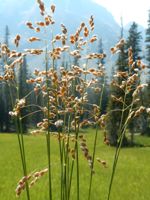Mon-Fri 9am - 5pm Mountain time
Pearly Everlasting vs Sweetgrass
Anthoxanthum hirtum/Anthoxanthum nitens (Hierochloe odorata))
Anaphalis margaritacea
CUSTOM GROW
CUSTOM GROW
Sweetgrass is a cool-season perennial grass best known for its sweet, vanilla-like fragrance. The scent comes from coumarin in the leaves, which is pleasant to humans but has a bitter taste that makes the plant less appealing to deer and other herbivores. As a cool-season grass, Sweetgrass grows most vigorously in spring and fall, slowing or even going dormant during the heat of summer.
It spreads quickly through creeping rhizomes and can be difficult to remove once established, so it is best planted in areas where its spread will not cause problems. Due to its deep, vigorous root system and preference for moist soils, Sweetgrass is especially useful for erosion control, soil stabilization, riparian plantings, and naturalization projects.
Note: Sweetgrass was formerly classified under the scientific name Hierochloe odorata and its subspecies. The subspecies found in Canada are currently considered two distinct species: Anthoxanthum hirtum, which is native across Canada, and Anthoxanthum nitens, which is native to Eastern Canada. Because these two species are alike and share many overlapping common names, they are often considered as only one species.
Pearly Everlasting is a native perennial wildflower known for its clusters of white, papery flowers with yellow centres. These long-lasting blooms appear throughout summer, and the silver-grey foliage adds contrast to the landscape. Its nectar supports a variety of pollinators and serves as a host plant for painted lady caterpillars.
Pearly Everlasting is also used in dried flower arrangements. It is well-suited for pollinator gardens, naturalization, ecological restoration, and low-maintenance landscapes.
Sweetgrass Quick Facts
Pearly Everlasting Quick Facts
Toxicity: toxic if large amounts ingested

